Studying the feed behaviour of horses in training - why we keep on losing the battle with ulcers?
Article by Catherine Rudenko
Is this the biggest challenge when it comes to managing digestive health for horses in training?
Keeping a racehorse healthy inside and out can be a real challenge. The nature of training and the environment in which racehorses live presents a constant set of risks. Managing those risks and balancing them against what is needed to achieve success is a fine art.
So where does risk come from when it comes to digestive function? Are those risks manageable within the racing environment? What can you realistically expect to achieve with changes to feed, feeding practice and the use of supplements?
One of the biggest risk factors for digestive health is the stabled environment and the pattern of feeding required to fit in around a typical working day for stable staff, coupled with the need to get out on the gallops. On top of this is then the individual’s feeding behaviour, something that can easily be overlooked when the ‘what is fed’ is the same for all horses on the yard. Individual behaviour is perhaps one of the hardest aspects to tackle, whilst replicating a natural feeding pattern is nearly impossible.
The most common digestive concern is gastric ulcers, and many feeds and supplements are now available and marketed for this condition. Yet ulcers still exist and continue to frustrate many trainers despite making dietary changes. Why is this? The answer lies in gaining a better understanding of what a ‘good’ feed pattern and diet looks like from the horses’ perspective versus what is effective for performance and realistic in a typical racing yard.
What is a natural feeding pattern?
Free ranging horses typically show 10-15 distinct feeding bouts in a 24-hour period (1).
Time spent resting or engaged in other non-feeding activities will not normally exceed 3-4 hours per session (2). Meaning the stomach is rarely truly empty.
The majority of feeding behaviour happens during daylight hours, typically 60-70% of time available (3).
During nighttime hours the amount of time spent as feeding behaviours reduces to 40-50% of those hours (3).
The total amount of time spent grazing across multiple feeding bouts is connected to the season and daylight hours. During summer months intake is around 14 hours in total versus 12 hours in the winter (4).
The natural feeding pattern is driven by the design of the horses’ digestive anatomy and is key to good health and normal function. The further away from these patterns we move any horse the greater the risk of dysfunction.
What is a typical feeding pattern for a horse in training?
The time study below shows the time taken for a group of 5 horses in training to eat their bucket feed and forage allocations in a 24-hour period. All horses in this observational study were in full training and worked in the morning of the study at different time points depending on their lot. Horses were observed from 4:45am until 9:15pm.
One of the key aspects of natural feeding behaviour is the amount of feeding periods or ‘mini-meals’ a horse consumes. For 4 out of the 5 horses from completion of their evening forage to the next meal of breakfast was a period of time in excess of 8 hours , approximately 33% of the 24-hour period. During these nighttime hours feeding behaviour normally occurs in free ranging horses and supports regulation of the digestive system.
For wild horses the total time spent eating is 12-14 hours in a 24 hour period. They do not normally have periods exceeding 12 hours in every 24 without some form of intake. For 4 out of the 5 horses there were distinct periods where all feed and forage had been consumed. The amount of time without any feed or forage available for the horses ranged from as little as 3 hours and 40 minutes up to 15 hours 30 mins in a 24-hour period.
Natural feeding patterns rarely see more than a 3-4 hour gap between each ‘mini-meal’ and at these points where gaps exist, it is important to remember that food has been available for 24 hours without restriction leading up to these chosen breaks in forage intake. The break in intake is short and during this time the stomach is unlikely to be truly empty. For horses in training it is easy to have periods in excess of 3 hours without any intake of feed or forage.
Although the period from finishing breakfast to morning forage being given was for some horses less than 3 hours, the stomach when receiving that breakfast was in a fasting state. Ordinarily in the natural environment the stomach is rarely truly empty as it can take anywhere from 2-6 hours for the stomach to empty depending on what and how much has been consumed (5). When giving a bucket feed to a horse in a fasting state the rate of transit of that feed through the stomach will be relatively short, and depending on which lot the horse is pulled out for, can result in the horse being worked on an empty or near empty stomach.
Why does this matter?
One of the common causes of squamous ulceration is ‘acid splashback’ which relates to strenuous exercise and the movement of acidic content from the lower glandular region of the stomach to the unprotected squamous area (6). When the stomach contains feed or forage it is more difficult for the acidic content to be forced upwards to the squamous area. This is why it is recommended to include chaff in the breakfast feed or provide a small amount of forage as these fibrous sources are slower to pass through the stomach and can help reduce the level of acidity seen in the proximal portion of the stomach. The key point here is reduction not elimination. The practice will not prevent ulceration occurring, but it will reduce exposure.
The table below shows the difference between horses that were fasted for only 2 hours before exercise and those fasted for 18 hours.
One of the challenges in racing is the differing amount of time between the breakfast feed and being saddled up for work. On top of this some horses will naturally consume their allocated feed faster. Even within the small number of horses observed in the study in Figure 1 there was notable variation in the time taken to eat the same amount of bucket feed given. Some of this variation comes from giving all horses the same breakfast by weight, which represents a different meal size against their bodyweight. Variation also exists as racehorses are individuals and appetite is flexible and influenced by other factors such as level of fitness and stress.
Figure 3 shows the amount of dry matter provided in the breakfast feed to each horse and considers it against the bodyweight of the individual horse. The breakfast given was 2.2kg of a cubed racing feed alongside 0.6kg of an alfalfa based chaff.
Can feed intake be slowed down?
In terms of feed format, pelleted feeds are consumed faster than mueslis or ‘sweet feeds’ (7). The addition of chaff mixed with the feed can slow intake, but for it to be effective there must be a reasonable amount given compared to the amount of pelleted or textured feed. As a rough guide, providing an additional 30% of the hard feed weight as a chaff will make a notable difference to the rate of intake.
Whilst the aim is to slow intake it is important to keep in mind that feeding hard feeds too close to strenuous exercise is not recommended. Ideally feed is withheld for 2 hours before exercise. Forages, eg hay, haylage and alfalfa chaff, do not need to be removed but intake should be restricted to a small amount, typically 1kg. Providing a small amount of forage in this format helps maintain saliva production, which assists with regulation of acidity, and provides some fill for the stomach.
Does forage intake matter?
Risk factors for gastric ulceration and colic when it comes to forage are similar. Diets low in forage and high in concentrates increase risk, along with intermittent feeding patterns and/or periods of fasting.
In addition to what is given and the pattern that fits practically at a yard, is the fact that horses, like many other species, do not have a fixed rate of intake when a meal of any sort is presented. The majority will have a higher consumption rate at the start of feeding than at the end. With the observed horses hourly weigh backs of forage were carried out for a period of 6 hours to determine rate of consumption. During this time no bucket feed was present. Figure 4 shows the individual intakes.
In the case of horses in training this is another problem to consider when it comes to evening feeds. Whilst the amount of forage given may be reasonable and in line with expected appetite, the feeding behaviour of the horse means there is not a consistent or regular intake of forage observed until the following morning feed. True feeding of ad-lib forage, above what a horse needs or could eat in a 24-hour period, is rarely given and often impractical. The reality is that most horses in training will have a prolonged period of zero feed or forage intake during nighttime hours, which is the opposite of natural feeding behaviour.
This is a practical challenge which for many yards is not easily overcome. Ideally forage should be fed at more regular intervals, rather than twice daily, to more closely replicate the 10-15 feeding bouts observed in wild horses.
What can be done to improve feed patterns?
Simply put, the longer a horse spends eating the better.
An enthusiastic eater that is ‘keen at the pot’ might be taken as a sign of good health, but a speedy intake that leads to a feeding pattern with longer periods between any sort of meal isn’t necessarily a good thing. A horse that appears a little slow with their forage but still consumes a good amount over a daily basis is not a bad thing as the pattern of eating is closer to multiple mini meals.
Using a good amount of chaff in every feed will prolong feed intake and requires additional chewing which helps increase salivation.
In the case of morning feeds ideally a little hay or haylage could be given, particularly for later lots to ensure the presence of some fibre in the stomach when working. Such a presence will not completely stop acidity in the delicate squamous area of the stomach, but it will reduce it.
Providing the evening forage as late as is possible to reduce the amount of time between evening forage being consumed and breakfast given.
Taking note of ‘speedy eaters’ and considering if hay nets or hay feeders would be appropriate to prolong the time taken to consume their evening allocation. Hay nets in different locations in the stable, for example one at the front and one at the back, can also influence how quickly all the forage is consumed.
Consider the type of forage given. Hay can be easier to provide on more of a free choice basis as horses will consume less hay than haylage on a dry matter basis in a set period of time (1).
What is a realistic expectation for managing digestive health?
The need for high energy intakes to fuel performance means reliance on hard feeds and a limited amount of forage. The horse does not have an unlimited appetite and even when provided with additional forage will not necessarily consume enough or consume it in a regular fashion. Replicating a natural feed pattern for horses in training is close to impossible and inevitably results in digestive disorders, but making changes and trying to reduce that risk is worth doing. The differences made may be small, but winning margins can be just as small.
The purpose of feeding low starch diets to horses in training is to reduce the specific element of risk that comes from high starch feeding. In doing so that element of risk is managed and the diet is one step closer to a more natural fibre-based diet. But it is one area of risk alone and mitigating this risk does nothing to control the risk of ulcers or colic from intermittent feeding, the impact of withholding water, the effect of travel and the physical effects on the stomach from strenuous exercise in the case of ulcers.
Using supplements that support healing of tissues, the function of mucus barriers or buffer acidity in the stomach are all part of trying to manage gastric ulcers, a disorder that is created through the training environment and the intensity of work required to achieve a race fit state. Such supplements are not designed to treat or prevent ulcers, they are not medicines and should not claim to do so, but they play an important part in trying to maintain a healthy digestive system.
Equally using supplements that support hindgut function through promoting the growth of beneficial bacteria, stabilising the pH of the hindgut or ‘mopping up’ pathogenic bacteria are all part of trying to maintain a healthy hindgut, which has many benefits, and reduces the risk of disorder within this section of the digestive anatomy.
The most important thing when considering gastric ulcers and other digestive disorders is to be realistic about what you can achieve within your environment, and to be realistic about what difference feeds and supplements alone can make. Any steps that can be taken to reduce risk are worth implementing as the aim is to keep the digestive system as healthy as possible so that the food you provide is converted to the nutrients needed to maximise performance and maintain general good health.
References
1. Ellis,A.D.,2010. Biological basis of behaviour in relation to nutrition and feed intake in horses. In A.D. Ellis, A.C.Longland, M.Coenen & N.Miraglia, ed. The impact of nutrition on the health and welfare of horses. The Netherlands: Wageningen Academic Publishers, 53-74
2. Ralston,1984; Vulink,2001, cited in Ellis,A.D.,2010. Biological basis of behaviour in relation to nutrition and feed intake in horses. In A.D. Ellis, A.C.Longland, M.Coenen & N.Miraglia, ed. The impact of nutrition on the health and welfare of horses. The Netherlands: Wageningen Academic Publishers, 58.
3. Vulnik,2001; Boyd 1988; Berger et al.,1999; Edouard et al.,2009 cited in Ellis,A.D.,2010. Biological basis of behaviour in relation to nutrition and feed intake in horses. In A.D. Ellis, A.C.Longland, M.Coenen & N.Miraglia, ed. The impact of nutrition on the health and welfare of horses. The Netherlands: Wageningen Academic Publishers, 58.
4. Vulnik,2001 cited in ELLIS,A.D.,2010. Biological basis of behaviour in relation to nutrition and feed intake in horses. In A.D. Ellis, A.C.Longland, M.Coenen & N.Miraglia, ed. The impact of nutrition on the health and welfare of horses. The Netherlands: Wageningen Academic Publishers, 59.
5. Frape, D. (2010) Equine Nutrition and Feeding. 4th Edition. United Kingdom: Wiley-Blackwell
6. Lorenzo-Figueras,M. Merrit,AM. Effects of exercise on gastric volume and pH in the proximal portion of the stomach of horses. Am J Vet Res. 2002;63(11):1481-1487
7. Hintz et al 1985 cited in Geor,J. Harris,P. Coenen,M. (2013) Equine Applied and Clinincal Nutrition. China: Elsevier
State-of-the-art training facilities come to China
By Sally Duckett
The dream for many trainers is to be based at a top-class state-of-the-art training centre with wonderful gallops, leading rehabilitation facilities, top-class staff accommodation as well as an ambitious site owner prepared to establish the facility as the very best of the best. For nine Hong Kong-based trainers, that dream has come true.
In August 2018, an eight-year project conceived by the Hong Kong Jockey Club (HKJC) came to fruition with the opening of its Conghua racecourse and training centre in China.
There is the slight downside for Sha Tin-based trainers, as the centre is a four-hour drive away from their main Hong Kong stables—across the border and in China. But every possible negative that it might have caused has been mitigated by the HKJC through discussion, cooperation with the Chinese authorities, big-planning, alongside the focused use of technology and ambitious ideas.
Nine trainers were invited to send horses to Conghua last autumn, and each has a string of between 15 to 20 horses based at the 150-hectare site—the trainers now termed ‘dual-site trainers’. Currently around 150 horses are in training at the €377 million facility, although by December 2018 the number of horses who had shipped to Conghua, returned to Sha Tin and travelled to China had already exceed 500 individuals.
The trainers were fully involved with the design and planning of Conghua from outset; the racecourse and gallops are in fact a replica of Sha Tin. Ensuring that the daily work and training processes are exactly the same, methods honed in Hong Kong can merely be picked up and transferred to China. There is though, at the trainers’ request, an additional 5f uphill straight gallop.
Selected trainers were invited to trial the Chinese venture and were chosen on their own abilities and that of their staff. The HKJC wanted to ensure that stable staff sent to China were capable and experienced.
The nine trainers with horses on site include leading trainers John Size, John Moore, Danny Shum, Casper Fownes and Tony Cruz.
All have been successful back in Hong Kong with their Conghua-trained horses (which are identified as such in the media for the betting public); and the Sha Tin nine are kept fully abreast of the training at Conghua courtesy of video, timing facilities and real-time technology all provided by the HKJC. The trainers, however, can spend as much time as they wish in China.
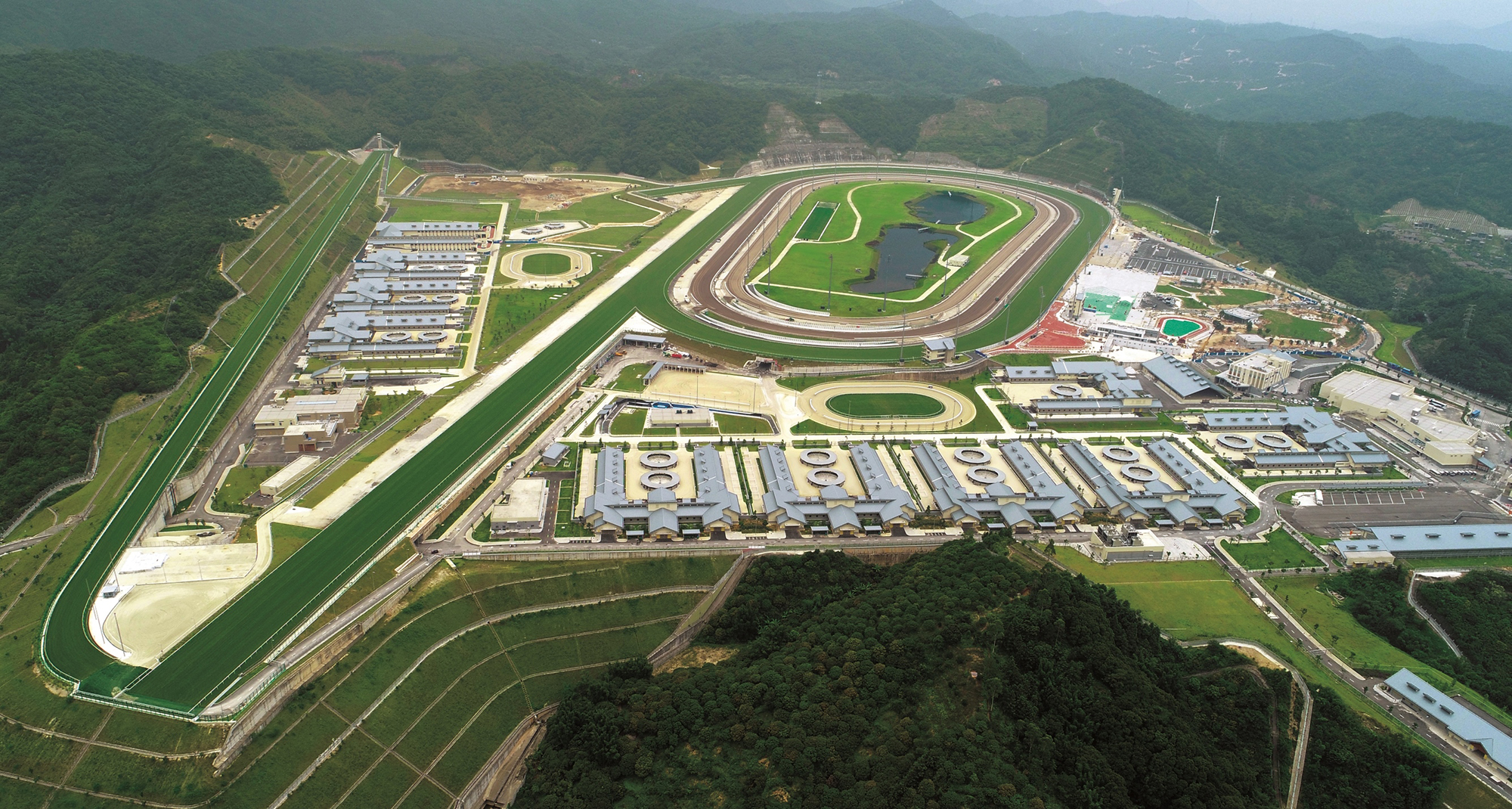
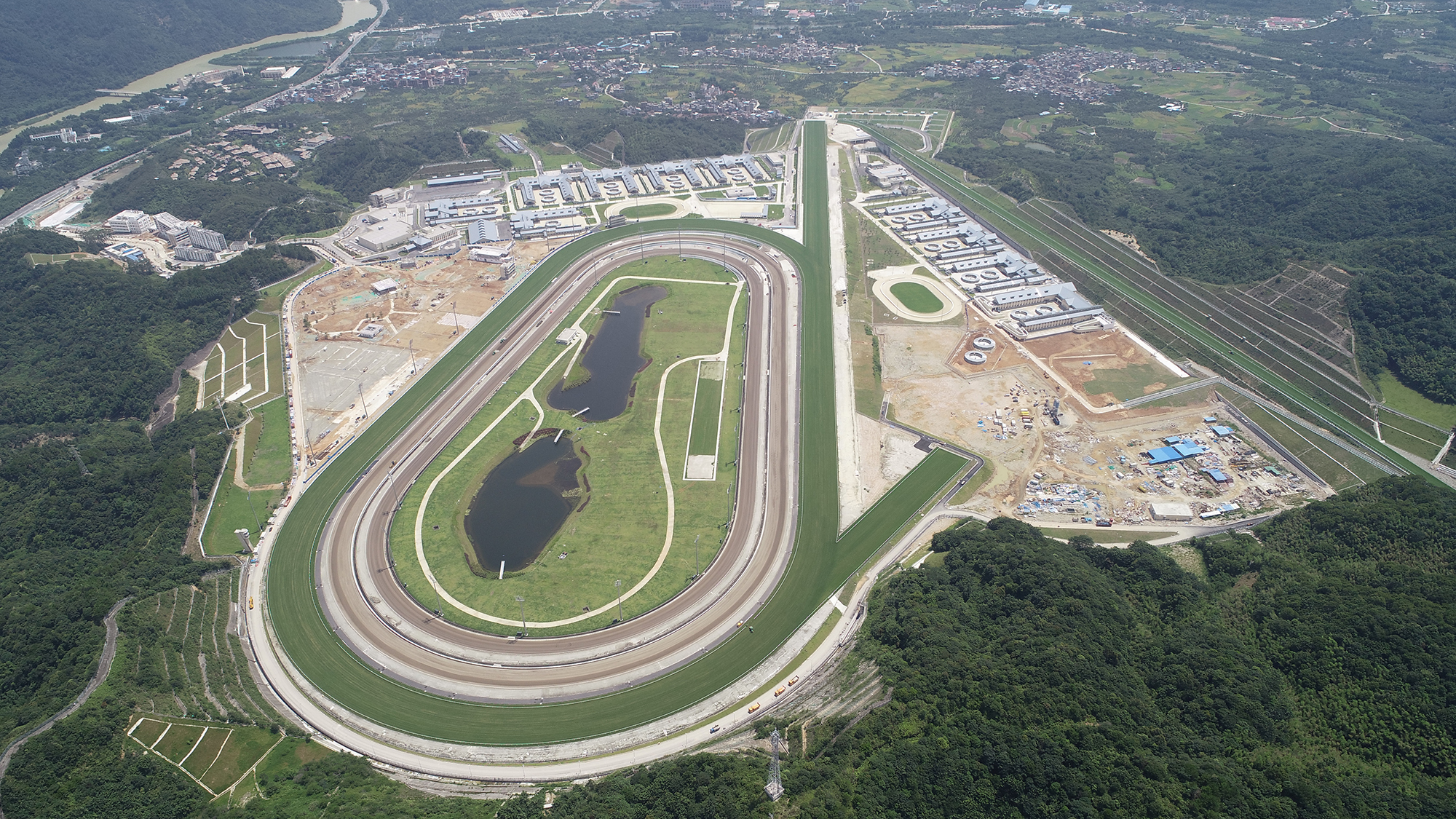
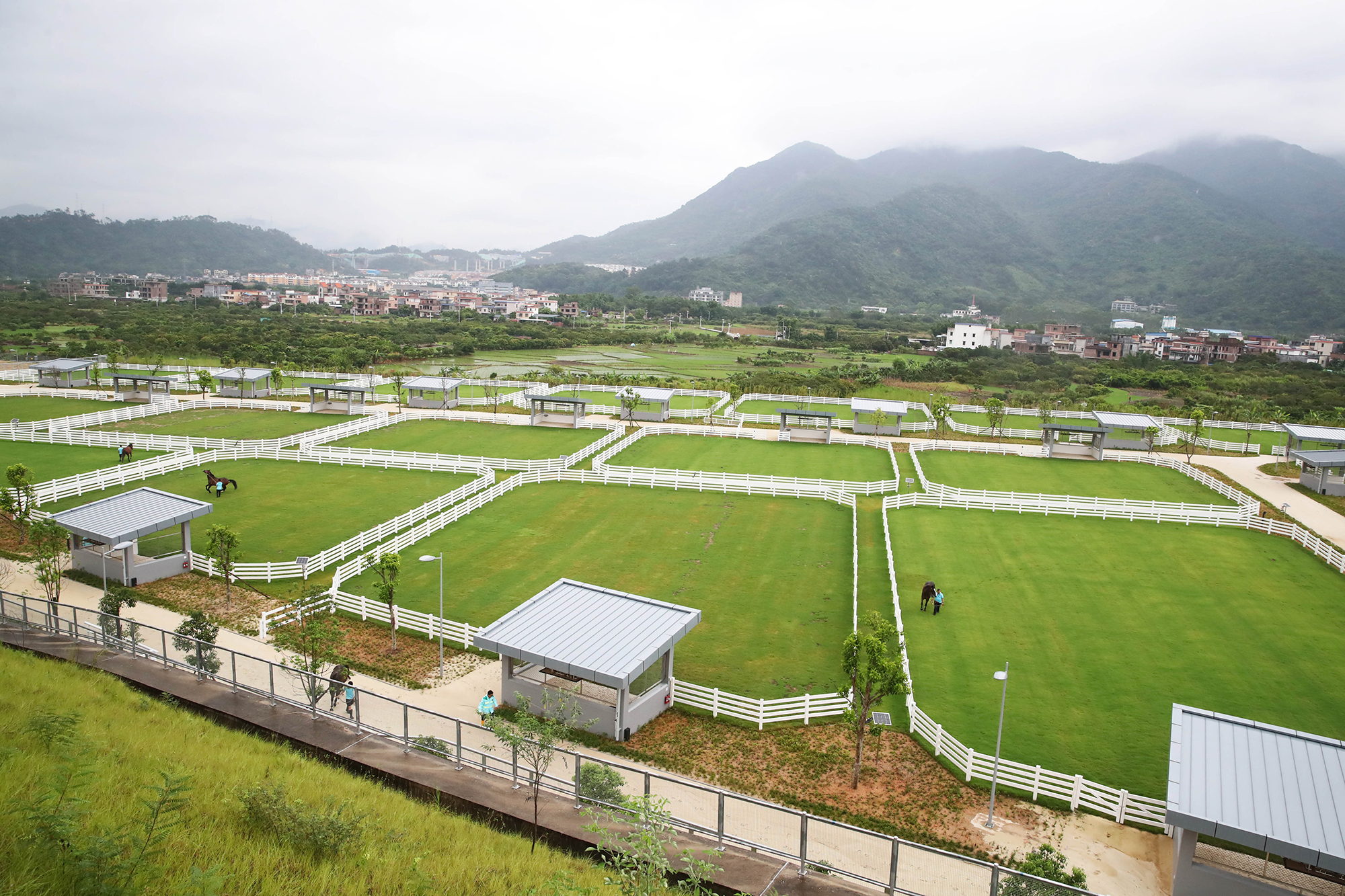
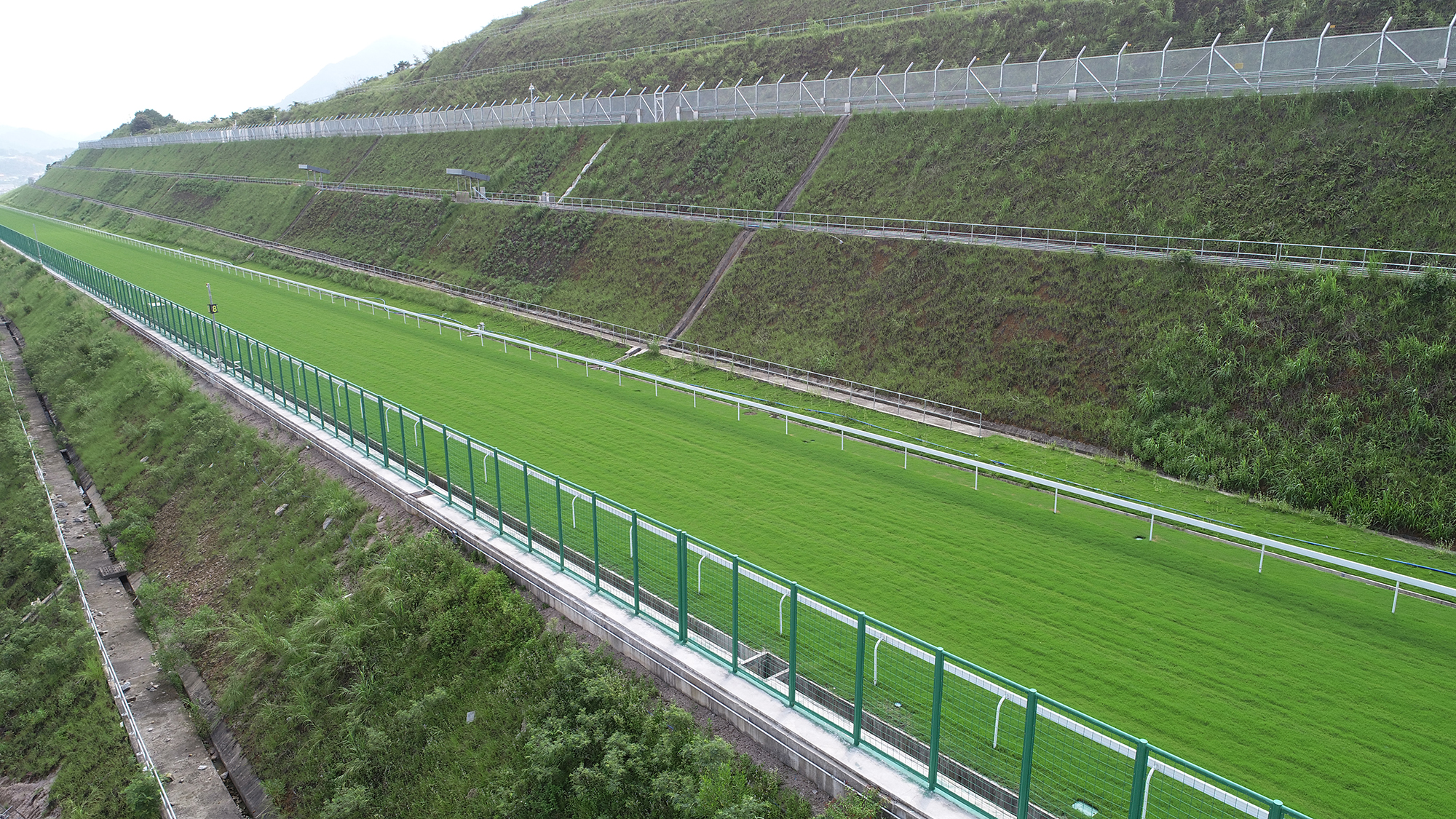
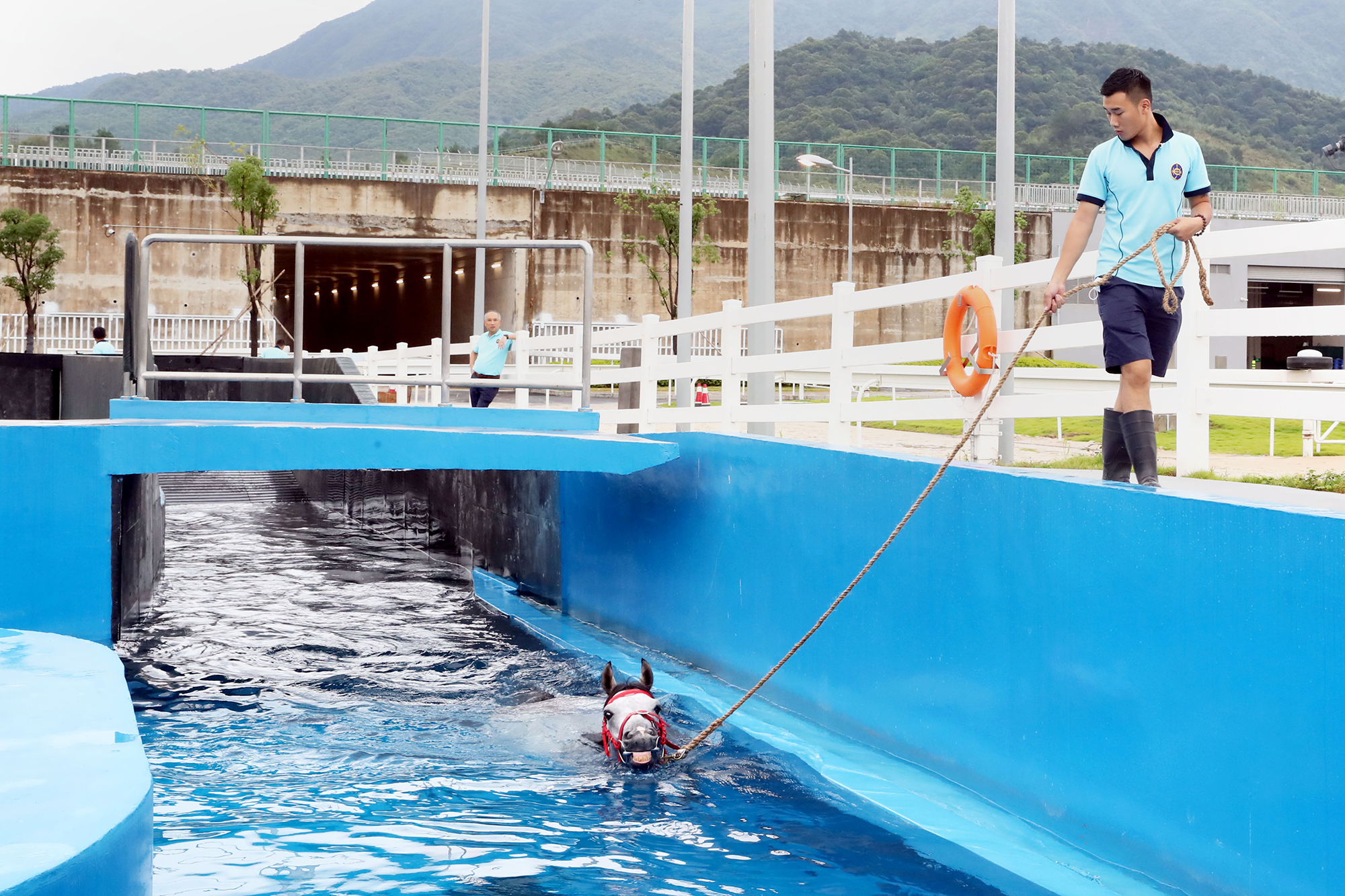
“John Size and Danny Shum in particular have spent a lot of time at Conghua”, reports Andrew Harding, the HKJC’s executive director of racing. “We have had applications from other trainers to send horses, and we will be adding another two later in the year”.
The success of the training process has kicked into gear quicker than even the ambitious HKJC team planned, and the site has already lost its initial ‘pre’ training tag.
“We had thought trainers would take horses back to Hong Kong two or three weeks ahead of a race, but they are travelling down and running just two days later—and winning”, smiles Harding. “We thought this would take perhaps a year to phase in, but it has come much quicker. The HKJC provides all the transportation, and we are already needing to ramp up the logistics—the transport initially between the two sites was twice a week, but we have extended it to six days a week (much earlier than anticipated). The travelling process had also been taking five business days to process with the levels of administration required for the border crossing, but our dual site trainers said that was too long. We have already narrowed that down to two days. Trainers can now ship on Monday in order to race on Wednesday at Happy Valley, and the horses need to undergo certain veterinary examinations ahead of racing; so they have to be in Hong Kong two days ahead of racing. They can then return to Conghua on Friday. The transport costs are all part of the HKJC’s service, and owners do not see any extra expense”.
Establishment of the Equine Disease Free Zone…





